
Computer & Network Systems Administration
Get started today
About Computer & Network Systems Administration
The Computer and Network Systems Administration program prepares students for employment in a wide variety of positions in the information technology field. Students work in a “live” network environment, managing their own servers, clients, routers, and switches by applying concepts learned in the theory classroom. The combination of theory and hands-on lab exercises allows CNSA students to acquire comprehensive skills in the following technical areas: The internal operation of personal and server computer systems; the physical infrastructure of local and wide area networks; the design and management of computer networks; the administration of Microsoft Windows and non-Windows server and client operating systems; the design and development of Windows-based and web-based applications; the management and design of relational databases; and the integration of enterprise software applications to solve business problems.
Upon completion of the program, graduates of the CNSA program have obtained employment in information technology as systems administrators, network administrators, network technicians, PC technicians, help desk analysts, systems engineers, structured data cabling installers, application programmers, web application developers, web administrators, database administrators, and sales engineers.
What you’ll learn
- Solve business problems by applying sound information technology principles.
- Implement and administer a broad range of information technology systems, networks, and applications.
- Manage information technology projects from conceptualization through implementation.
- Make significant contributions as a member of an information technology team.
- Explain with authority current technologies and standards in the field.
- Maintain information technology skills through appropriate industry certifications and/or continuing education.
- Demonstrate a strong professional work ethic.
- Protect and preserve a business organization’s critical information assets from all threats.
Sample Job Titles
Systems administrators, network administrators, network technicians, PC technicians, help desk analysts, systems engineers, structured data cabling installers, application programmers, web application developers, web administrators, database administrators, and sales engineers.
Soar Agreements
This program enables students to apply certain credits earned in high school to the credits needed for a degree or certificate through Thaddeus Stevens College. Computer & Network Systems Administration degree qualifies for this program – see our SOAR program page for details!
Quick facts
Location
Kreider Building, Main Campus
Type of program
Associate Degree
Job/Salary Outlook
See industry data
Length of program
2 years, 73 credits
Cost of program
$4,500/semester tuition
$3,000 – $3,500/semester housing
$1,850 – $2,335/semester meal plan
Tool List (PDF)

The outcomes speak for themselves
Upon completion of the program, graduates of the CNSA program have obtained employment in information technology as systems administrators, network administrators, network technicians, PC technicians, help desk analysts, systems engineers, structured data cabling installers, application programmers, web application developers, web administrators, database administrators, and sales engineers.
73.4%
employment
$62.5K
med. salary
20%
cont. education
People of TSCT
Success stories
Program details
Courses
MODEL SCHEDULE FOR COMPUTER & NETWORK SYSTEMS ADMINISTRATION (OPTION #1)
Semester 1
- CNSA 107 PC Hardware and Support Fundamentals (3 credits)
- CNSA 111 Intro to Networking (3 credits)
- CNSA 117 Analysis of TCP/IP & Local Area Networking (3 credits)
- CNSA 123 LAN Cabling and WAN Technologies (3 credits)
- ENG 106 English Composition (3 credits)
- MATH 137 Intermediate Algebra (3 credits)
Semester 2
- CNSA 156 Operating Systems I (3 credits)
- CNSA 161 Systems Administration I (3 credits)
- CNSA 166 Internetworking Devices and Concepts (3 credits)
- CNSA 172 Web Technologies and Network Security Fund (3 credits)
- MATH 141 Trigonometry (3 credits)
- ENG 216 Technical Report Writing (3 credits)
Semester 3
- CNSA 212 Programming I (3 credits)
- CNSA 222 Database Management Systems (3 credits)
- CNSA 227 Management Information Systems (3 credits)
- CNSA 256 Operating Systems II (3 credits)
- ELECTIVE General Elective (3 credits)
- ENG 221 Public Speaking (3 credits)
Semester 4
- CNSA 216 Web Programming (3 credits)
- CNSA 266 Systems Administration II (3 credits)
- CNSA 271 Network Design (3 credits)
- CNSA 276 Practical Applications (3 credits)
- SCIENCE Elective (3 credits)
- HUMANITIES Elective (3 credits)
Additional General Education Requirements
- HEAL Elective HEAL 106 or HEAL 111 (1 credit)
Total Credits 73
COMPUTER & NETWORK SYSTEMS ADMINISTRATION (OPTION #2)
Semester 1
- CNSA 107 PC Hardware and Support Fundamentals 3
- CNSA 111 Intro to Networking 3
- CNSA 117 Analysis of TCP/IP & Local Area Networking 3
- CNSA 123 LAN Cabling and WAN Technologies 3
- ENG 106 English Composition 3
- Math 207 Pre-Calculus 4
Semester 2
- CNSA 156 Operating Systems I 3
- CNSA 161 Systems Administration I 3
- CNSA 166 Internetworking Devices and Concepts 3
- CNSA 172 Web Technologies and Network Security Fund 3
- ENG 216 Technical Report Writing 3
Semester 3
- CNSA 212 Programming I 3
- CNSA 222 Database Management Systems 3
- CNSA 227 Management Information Systems 3
- CNSA 256 Operating Systems II 3
- ENG 221 Public Speaking 3
Semester 4
- CNSA 216 Web Programming 3
- CNSA 266 Systems Administration II 3
- CNSA 271 Network Design 3
- CNSA 276 Practical Applications 3
- PHYS 106 Physics in Everyday life (or Higher) 3
- HUMANITIES Elective 3
Additional General Education Requirements
- ELECTIVE General Elective 3
- HEAL Elective HEAL 106 or HEAL 111 1
Total Credits 74
Faculty
Matthew McLaughlin
Instructor, Computer Network & Systems Administration 1st mclaughlin@stevenscollege.eduJameson McFarlane
Professor, Computer Network & Software Administration 2nd mcfarlane@stevenscollege.eduRebecca Schultz
Instructor, Computer Network & Systems Administration 1st schultz@stevenscollege.eduOccupational Advisory Committee
The Occupational Advisory Committee (OAC) serves as a vital link between the Program of study and industry, ensuring that the program remains aligned with current workforce needs, technological advancements, and best practices in the field. Composed of employers, educators, and other community members, the committee provides guidance, feedback, and recommendations to enhance the curriculum, instructional methods, and student learning experiences.
Purpose and Responsibilities:
- Curriculum & Industry Alignment
- Workforce Readiness
- Student & Faculty Support
- Internship & Employment Connections
- Accreditation & Program Evaluation
- Facilities & Equipment Recommendations
By fostering a strong relationship between academia and industry, the OAC helps ensure that Thaddeus Stevens College programs maintain the highest standards in CTE (career and technical education).
- Madonna Arntz, Amrstrong World Industries
- Chad Burger, DentsplySirona
- Matt Carroll, Clair Global
- Christine Cruz, Clark Associates
- Mitchel Erb, Benchmark Construction Company
- Kevin Flory, retired
- Timothy Headings, retired
- Tyler Hildebrand, Clark Associates
- Megan Hirst, Clark Associates
- Shawn Mellinger, Oxford Area School District
- Brandon Pearce, Match Group
- Evan Phyillaier, Ecore International Inc.
- Adam Schaeffer, Full Span Solutions
- Billy Sprankle, One 2 One Inc.
- Evan Templin, Crestwood Associates
- Eric Velky, The Conrad Company
Gregory Weichert, ConnectUs Corp
Essential Skills Learned
Tasks
- Back up network data.
- Configure security settings or access permissions for groups or individuals.
- Analyze and report computer network security breaches or attempted breaches.
- Identify the causes of networking problems, using diagnostic testing software and equipment.
- Document network support activities.
- Configure wide area network (WAN) or local area network (LAN) routers or related equipment.
- Install network software, including security or firewall software.
- Install, configure, and maintain domain controllers, DNS, DHCP, email, and web servers.
- Build, maintain, troubleshoot, and repair desktop computers.
- Design, implement, and configure databases.
- Windows and web development.
Tools used in this occupation
- Access servers — Remote access servers
- Circuit tester — Continuity testers; Test lights
- Computer servers — Caching engines; Network Address Translation (NAT) appliances, Domain Controllers, DNS, DHCP, and Web servers
- Hard disk arrays — Redundant array of independent disks RAID systems
- Printers – Laser, Ink Jet, and All-in-One print devices
- Network devices – Routers, switches, patch panels, cabling, and access points
- Mainframe computers
Technology used in this occupation
- Configuration management software — Automated installation software; EMC Ionix Network Configuration Manager; Patch and update management software; VMWare
- Network monitoring software — Dartware InterMapper; Nagios; WildPackets OmniPeek Network Analyzer; Wireshark
- Operating system software — Bash; Microsoft Windows Server; Red Hat Enterprise Linux; UNIX Shell
- Presentation software — Microsoft PowerPoint
- Transaction security and virus protection software — Encryption software; McAfee; Symantec; Symantec Norton Antivirus
Education
- This occupation may require a background in the following science, technology, engineering, and mathematics (STEM) educational disciplines:
- Computer Science – Computer and Information Sciences, General; Computer and Information Systems Security; Computer Systems Analysis/Analyst; Computer Systems Networking and Telecommunications
Skills
- Critical Thinking — Using logic and reasoning to identify the strengths and weaknesses of alternative solutions, conclusions or approaches to problems.
- Active Listening — Giving full attention to what other people are saying, taking time to understand the points being made, asking questions as appropriate, and not interrupting at inappropriate times.
- Judgment and Decision Making — Considering the relative costs and benefits of potential actions to choose the most appropriate one.
- Reading Comprehension — Understanding written sentences and paragraphs in work-related documents.
- Active Learning — Understanding the implications of new information for both current and future problem-solving and decision-making.
- Complex Problem Solving — Identifying complex problems and reviewing related information to develop and evaluate options and implement solutions.
- Monitoring — Monitoring/Assessing performance of yourself, other individuals, or organizations to make improvements or take corrective action.
- Speaking — Talking to others to convey information effectively.
Abilities
- Deductive Reasoning — The ability to apply general rules to specific problems to produce answers that make sense.
- Oral Comprehension — The ability to listen to and understand information and ideas presented through spoken words and sentences.
- Problem Sensitivity — The ability to tell when something is wrong or is likely to go wrong. It does not involve solving the problem, only recognizing there is a problem.
- Inductive Reasoning — The ability to combine pieces of information to form general rules or conclusions (includes finding a relationship among seemingly unrelated events).
- Oral Expression — The ability to communicate information and ideas in speaking so others will understand.
- Written Comprehension — The ability to read and understand information and ideas presented in writing.
- Information Ordering — The ability to arrange things or actions in a certain order or pattern according to a specific rule or set of rules (e.g., patterns of numbers, letters, words, pictures, mathematical operations).
- Near Vision — The ability to see details at close range (within a few feet of the observer).
Work Activities
- Interacting With Computers — Using computers and computer systems (including hardware and software) to program, write software, set up functions, enter data, or process information.
- Updating and Using Relevant Knowledge — Keeping up-to-date technically and applying new knowledge to your job.
- Getting Information — Observing, receiving, and otherwise obtaining information from all relevant sources.
- Communicating with Supervisors, Peers, or Subordinates — Providing information to supervisors, co-workers, and subordinates by telephone, in written form, e-mail, or in person.
- Establishing and Maintaining Interpersonal Relationships — Developing constructive and cooperative working relationships with others, and maintaining them over time.
- Making Decisions and Solving Problems — Analyzing information and evaluating results to choose the best solution and solve problems.
- Analyzing Data or Information — Identifying the underlying principles, reasons, or facts of information by breaking down information or data into separate parts.
- Processing Information — Compiling, coding, categorizing, calculating, tabulating, auditing, or verifying information or data.
- Organizing, Planning, and Prioritizing Work — Developing specific goals and plans to prioritize, organize, and accomplish your work.
Work Context
- Electronic Mail — 94% responded “Every day.”
- Telephone — 93% responded “Every day.”
- Indoors, Environmentally Controlled — 84% responded “Every day.”
- Face-to-Face Discussions — 80% responded “Every day.”
- Contact With Others — 79% responded “Constant contact with others.”
- Work With Work Group or Team — 68% responded “Extremely important.”
- Importance of Being Exact or Accurate — 64% responded “Extremely important.”
- Structured versus Unstructured Work — 57% responded “Some freedom.”
- Freedom to Make Decisions — 49% responded “A lot of freedom.”
Work Styles
- Cooperation — Job requires being pleasant with others on the job and displaying a good-natured, cooperative attitude.
- Analytical Thinking — Job requires analyzing information and using logic to address work-related issues and problems.
- Attention to Detail — Job requires being careful about detail and thorough in completing work tasks.
- Dependability — Job requires being reliable, responsible, and dependable, and fulfilling obligations.
- Integrity — Job requires being honest and ethical.
- Adaptability/Flexibility — Job requires being open to change (positive or negative) and to considerable variety in the workplace.
- Initiative — Job requires a willingness to take on responsibilities and challenges.
- Self-Control — Job requires maintaining composure, keeping emotions in check, controlling anger, and avoiding aggressive behavior, even in very difficult situations.
- Stress Tolerance — Job requires accepting criticism and dealing calmly and effectively with high-stress situations.
Work Values
- Achievement – Occupations that satisfy this work value are results-oriented and allow employees to use their strongest abilities, giving them a feeling of accomplishment. Corresponding needs are Ability Utilization and Achievement.
- Support – Occupations that satisfy this work value offer supportive management that stands behind employees. Corresponding needs are Company Policies, Supervision: Human Relations and Supervision: Technical.
- Working Conditions – Occupations that satisfy this work value offer job security and good working conditions. Corresponding needs are Activity, Compensation, Independence, Security, Variety, and Working Conditions.
Performance Measures
Internal Key Performance Indicators (Sources: Internal data collections, and Post-Graduate Surveys)
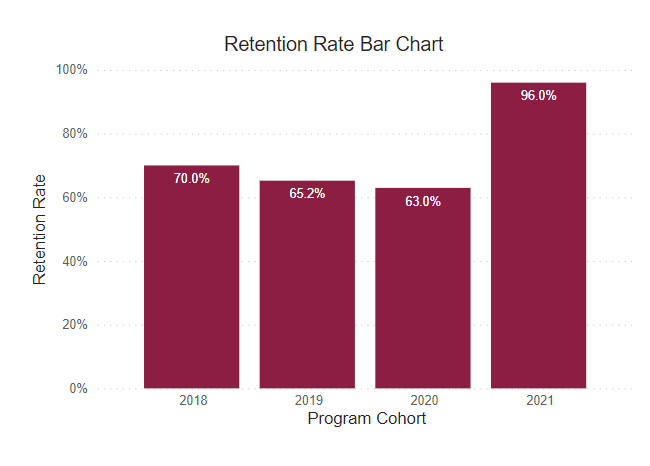
Retention Rate
This rate reflects the continuous term-to-term persistence rate for certificate programs and the fall-to-fall retention rate for associate degree programs.
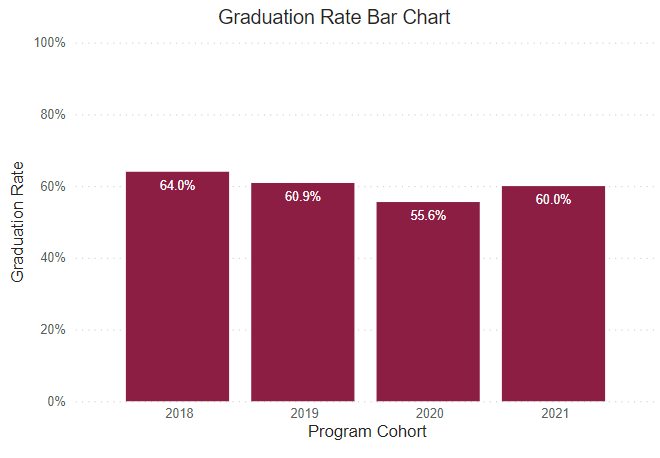
Graduation Rate
This rate reflects the number of freshmen who were officially enrolled in the fall semester and earned a certificate or degree within the expected timeframe.
Post Graduate Survey Response Rate
The post graduate survey is an annual on-line post graduate survey utilized by the college to gather vital information regarding career placement, starting salary, and level of satisfaction.
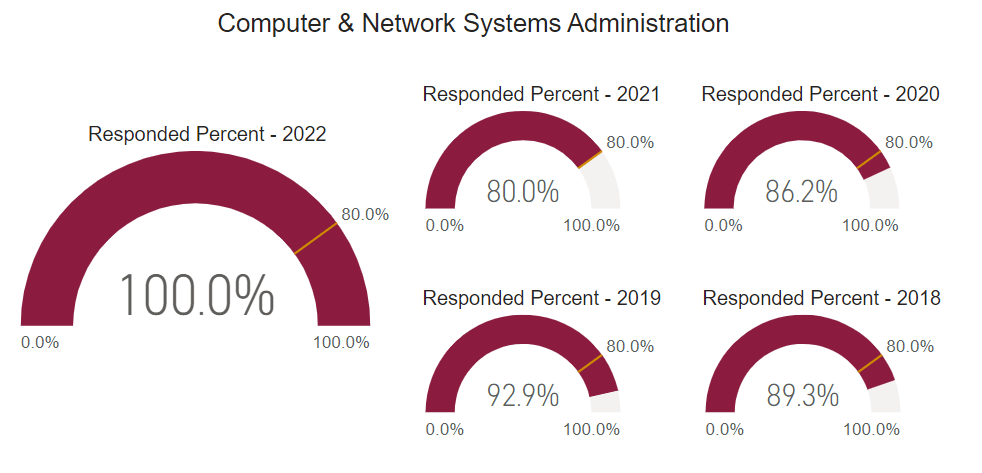
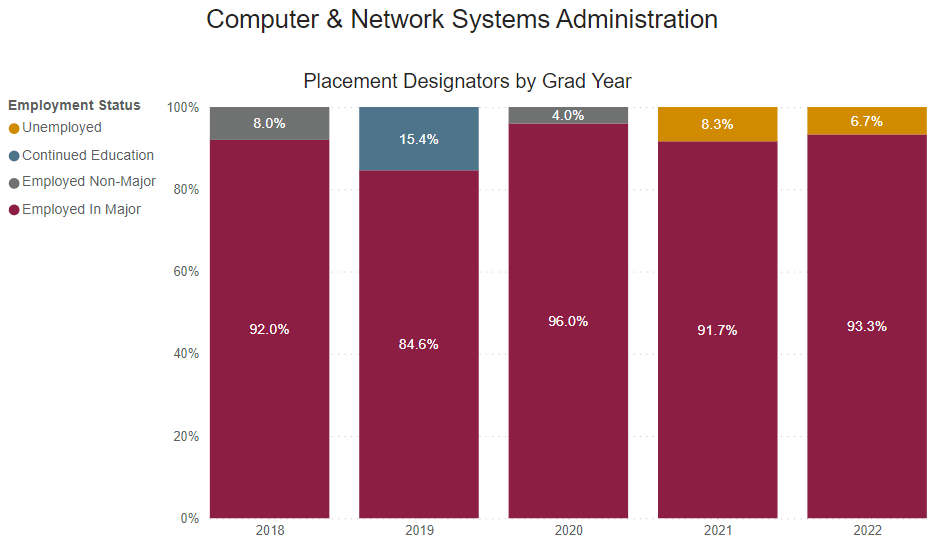
Employed Full Time Outside of Major
Percentage of graduates who reported being employed full-time outside their field of study.
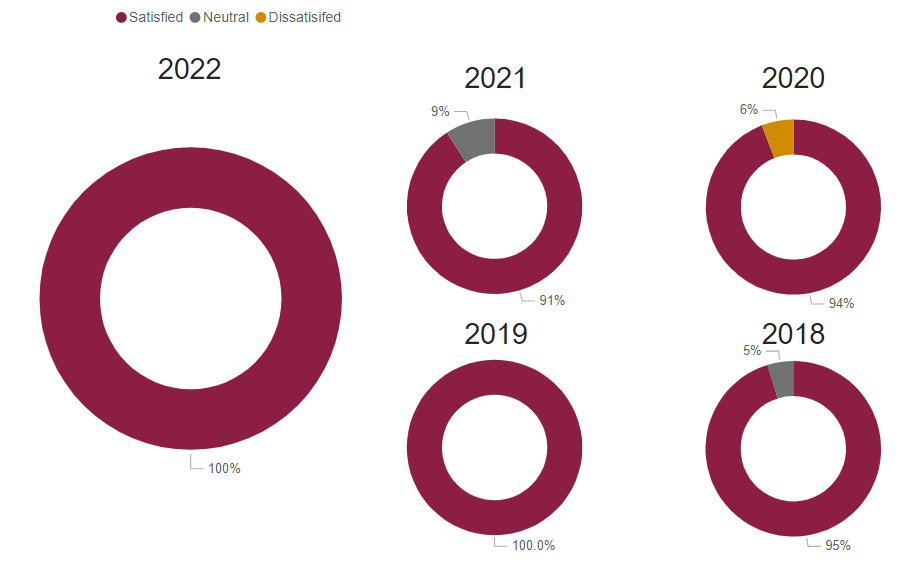
Graduate Satisfaction
This is the median graduate survey response evaluating the level of preparation for workforce entry (based on a 5-Item Likert Scale).
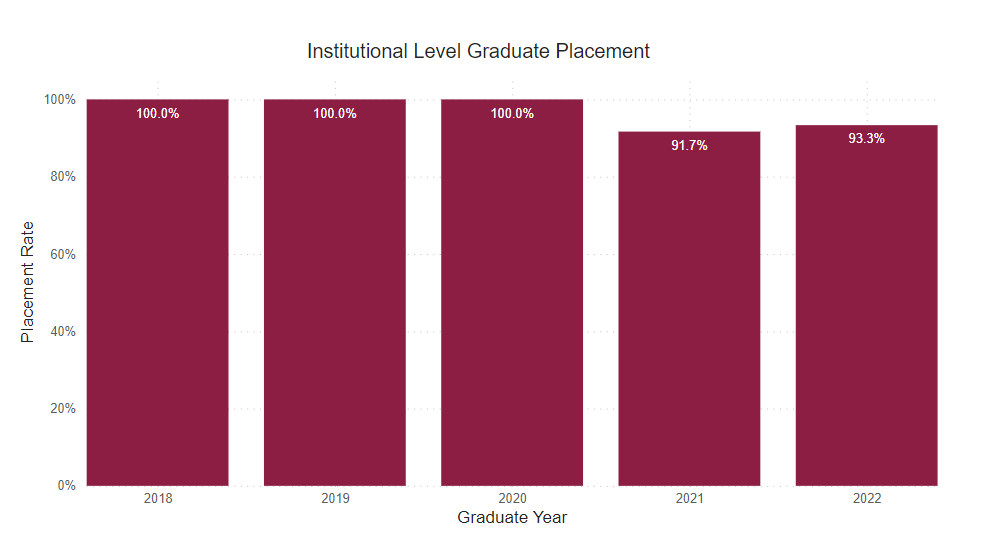
Placement Rate
This is the percent of graduate survey respondents who reported being employed or continued their education on a full-time basis.

Employed Full Time Within Major
Percentage of graduates who reported being employed full-time within their field of study.

Annual Median Starting Salary
This number is based on the graduate survey response to the request to identify a starting salary from a range of options. This graph shows the median first-year annual salary. All calculations are based on the respondent’s self-reported first-year annual income.
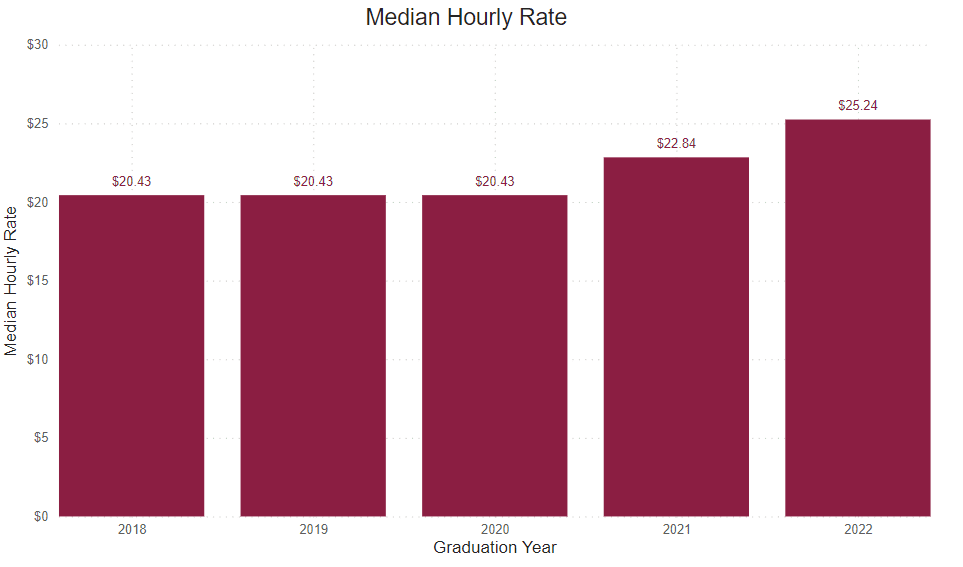
Reported Hourly Rate
This number is determined by dividing the reported median salary by the number of hours in a traditional full-time work week (40), then the number of weeks in a year (52).

Our graduates work with the industry’s best




